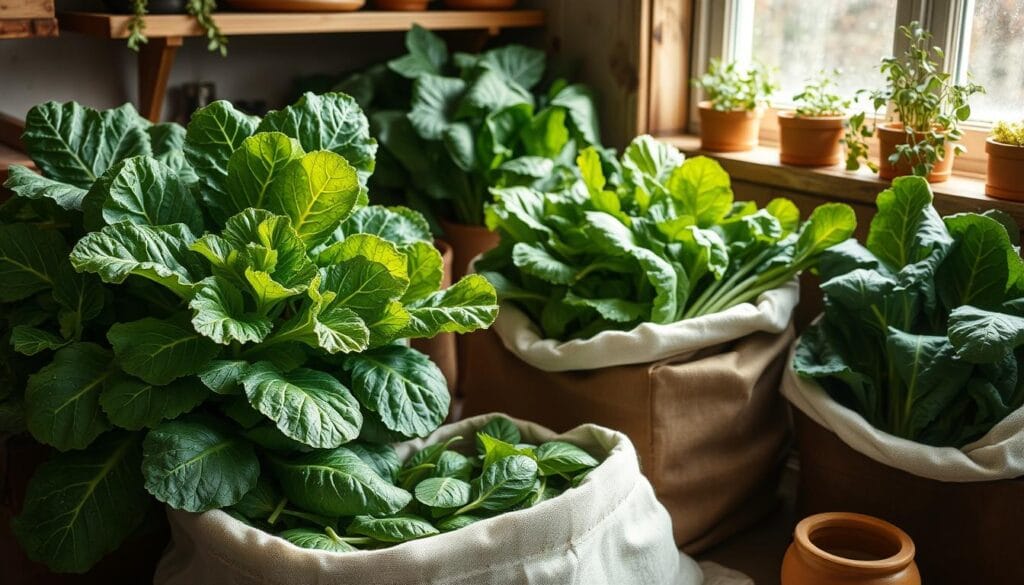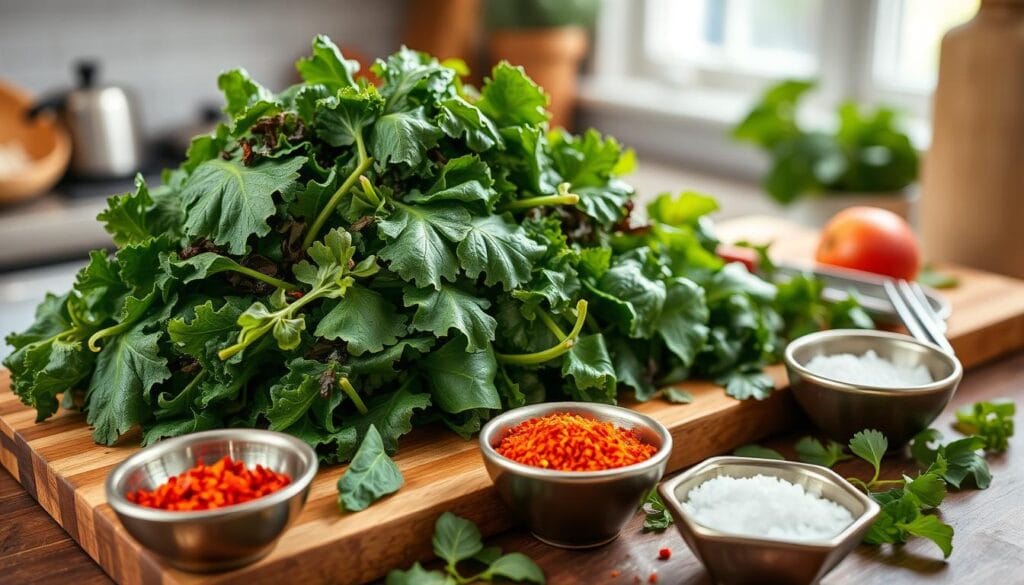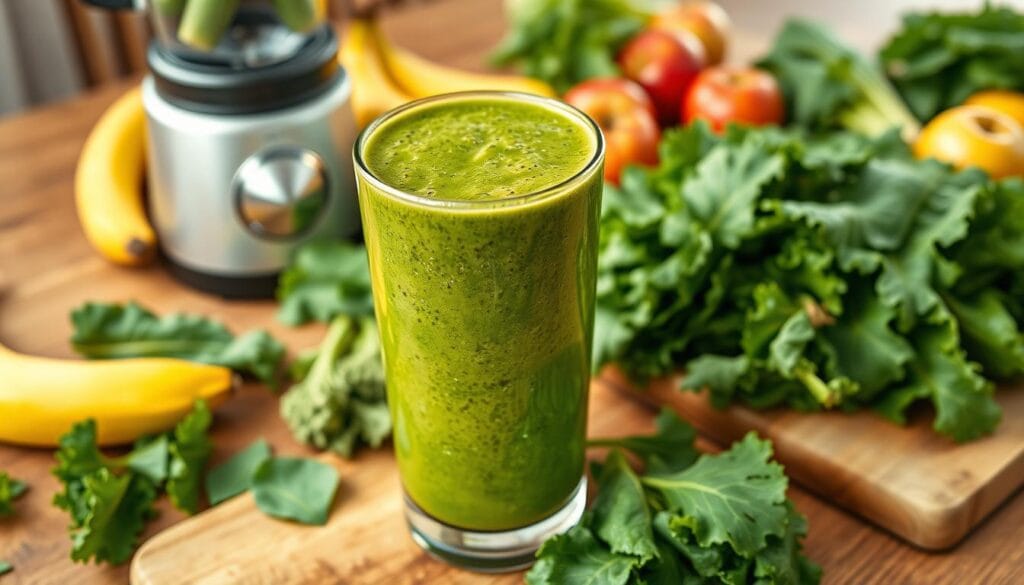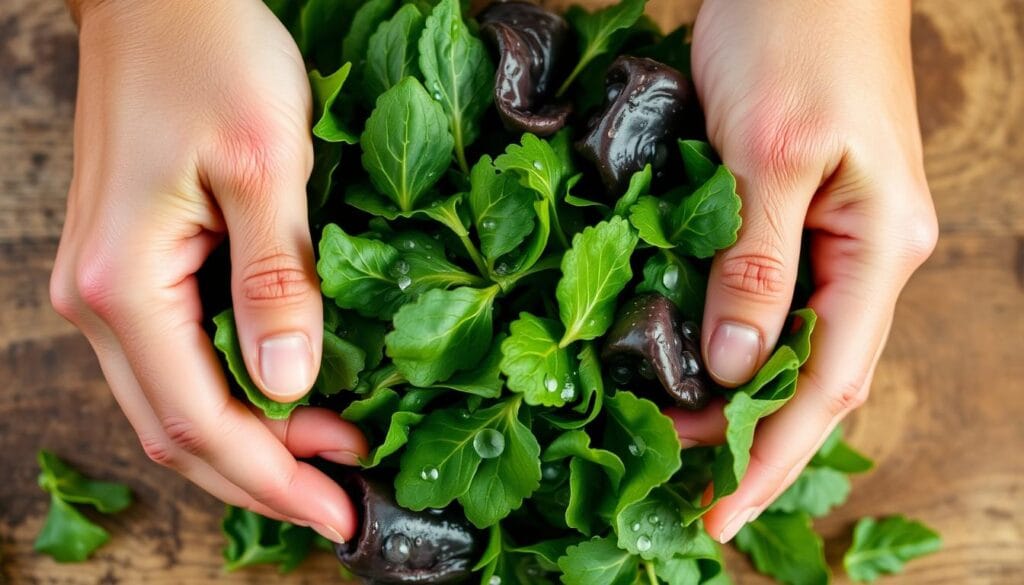Walking through the farmer’s market, I see kale, collards, and Swiss chard. These greens are full of nutrients like calcium and vitamins A, B, C, and K. They’ve been good for us for centuries. But adding them to our busy lives can seem hard. Don’t worry, we’ll show you how to easily enjoy their fresh flavors. This guide will cover many types of Prepping Hearty Greens. We’ll talk about their health benefits and how to pick, clean, and cook them. Whether you love greens or are new to them, get ready to learn and enjoy.
Understanding Hearty Greens
Hearty greens are strong, leafy veggies packed with nutrients. They include kale, collard greens, Swiss chard, mustard greens, and bok choy. These greens are full of vitamins, minerals, and antioxidants.
What Are Hearty Greens?
Hearty greens have thick, sturdy leaves and a robust texture. They can handle longer cooking times without losing flavor. They’re known for their high nutritional value, offering a lot of calcium, magnesium, potassium, iron, and vitamins.
Nutritional Benefits of Hearty Greens
Eating hearty greens can boost your health. They help slow down cognitive decline as you age. These greens also support heart health, strengthen bones, and improve overall well-being. They’re easy to add to many meals, making them great for a healthy diet.
| Nutrient | Kale | Collard Greens | Swiss Chard | Mustard Greens | Bok Choy |
|---|---|---|---|---|---|
| Calcium (mg) | 94 | 357 | 101 | 64 | 74 |
| Magnesium (mg) | 31 | 43 | 31 | 14 | 9 |
| Potassium (mg) | 243 | 329 | 379 | 52 | 122 |
| Iron (mg) | 1.1 | 0.7 | 1.8 | 0.7 | 0.5 |
| Vitamin A (IU) | 5,984 | 5,992 | 4,896 | 5,558 | 476 |
| Vitamin C (mg) | 80.4 | 35.3 | 32.0 | 71.6 | 51.3 |
| Vitamin K (mcg) | 564.6 | 1,064.6 | 778.8 | 594.3 | 54.8 |
Choosing the Right Hearty Greens
Finding the perfect hearty greens for your meals can be tricky. But, with a little knowledge, you can explore the world of leafy veggies easily. You’ll find everything from the strong taste of kale to the sweet baby bok choy. Each offers a special taste experience.
Popular Varieties to Consider
Some top hearty greens include green kale, purple kale, and dinosaur kale. Also, bok choy, baby bok choy, mustard greens, collard greens, turnip greens, and peppery arugula are favorites. Each has its own flavor and texture, perfect for many dishes.
Seasonal Availability and Selection Tips
Hearty greens are usually at their best from September to May. When picking seasonal greens, look for crisp, dark leaves without discoloration or wilting. Buying from local farmers’ markets means they last up to a week. Store-bought greens, like spinach, might only last two to three days.
Choosing the freshest leafy greens ensures your meals are full of flavor and nutrients.
“Incorporating a variety of fresh greens into your diet is a simple way to boost your intake of essential vitamins, minerals, and fiber.”
Washing and Cleaning Hearty Greens
Importance of Proper Cleaning
It’s very important to clean hearty greens well. This makes sure they are safe to eat and taste great. Washing them removes dirt and harmful stuff, keeping you healthy.
Also, clean greens last longer and look and taste better. They stay fresh and full of flavor.
Step-by-Step Cleaning Process
To clean your hearty greens, follow these simple steps:
- Start by removing any rubber bands, twist ties, or wire fasteners.
- Take off the leaves from the tough stems. Save the stems for cooking.
- Break the big leaves into smaller pieces.
- Put the greens in a big bowl with cold water. Swish them around to get rid of dirt.
- Let them sit for a few minutes. This lets dirt settle at the bottom.
- Move the greens to a colander. Wash them again until the water is clear.
- Use a salad spinner or towels to dry the greens. This removes extra water.
- Spread the greens on towels to dry more. Then, you can store or use them.
By following these steps, you can make sure your greens are clean and ready for cooking.
“Washing leafy greens properly is crucial to food safety as some foodborne illnesses have been linked to fresh leafy greens.”
| Cleaning Technique | Benefits |
|---|---|
| Washing greens in cold water | Removes dirt, debris, and contaminants |
| Letting greens soak for a few minutes | Allows sediment to sink to the bottom |
| Repeating the washing process | Ensures thorough cleaning |
| Drying greens with a salad spinner or towels | Prevents spoilage and extends freshness |
By using these cleaning methods, you can enjoy your greens’ fresh taste and longer shelf life. You’ll also keep your food safe.
Storing Hearty Greens
Storing your leafy greens right is key to keeping them fresh. Whether you’ve picked them yourself or bought them, these tips will help. You can enjoy your fresh greens for a while or save them for later.
Best Practices for Short-Term Storage
To keep your leafy greens fresh for up to 10 days, just follow these steps:
- Put the clean, dry greens in a big resealable bag, like a gallon-size Ziplock.
- Use a clean dish towel or paper towels to soak up extra moisture in the bag.
- Press the bag to get rid of air, then seal it tight.
- Put the bag in the fridge. Make sure the greens have room to breathe.
Long-Term Storage Methods
For keeping your leafy greens fresh for months, try blanching and freezing. This method keeps their color, taste, and texture great, even from the freezer.
- Wash and dry the greens well.
- Blanch them in boiling water for 1-2 minutes, then cool them in an ice bath.
- Drain and dry the greens with a towel.
- Put the blanched greens in airtight containers or freezer bags, getting rid of air.
- Mark the containers with what’s inside and when, then freeze for up to 6 months.
With these storage tips, you can enjoy leafy greens all year. They’re perfect for quick salads or hearty meals.
Cooking Hearty Greens: Basic Techniques
Learning to cook hearty greens opens up a world of tasty and healthy dishes. Two key methods to try are sautéing and steaming. Each method brings out the best in these versatile veggies.
Sautéing Greens
Sautéing is a fast and tasty way to cook greens like kale, broccoli rabe, and bok choy. Begin by heating some oil in a skillet over medium-high. Add minced garlic and sliced scallions, letting them sizzle and fill the air with their scent.
Next, add your chopped or torn greens. A bit of soy sauce or a liquid like water or lemon can boost the flavors. Cover the pan and let the greens steam for a few minutes until they’re tender.
Steaming for Nutrient Retention
Steaming is a gentle way to cook greens that keeps their nutrients intact. Place the greens in a steamer basket over boiling water. Cover and steam for 3 to 5 minutes, depending on the green and your preference.
This method keeps the greens’ colors bright and their textures soft. It makes them a healthy and tasty part of your meals.
| Dish | Calories per Serving |
|---|---|
| Spinach-Orzo Salad | 122 calories per 3/4 cup |
| Slow-Cooker Spinach & Rice | 488 calories per serving |
| Swiss Chard Bean Soup | 94 calories per cup |
| Collard Greens with Bacon | 157 calories per 3/4 cup |
Whether you sauté or steam your greens, these basic techniques can bring out their full flavor and nutritional value.
Flavoring Hearty Greens
It’s easy to make your hearty greens taste better with a few tricks. Try using herbs and spices like garlic, ginger, and crushed red pepper for a kick. Balsamic vinegar adds a tangy Italian taste. Mix different flavors to find your favorite seasoning for leafy greens.
The cooking oil you pick can change how your greens taste. Sesame oil gives a nutty flavor, perfect for Asian dishes. Olive oil is great for Mediterranean flavors. For more taste, use garlic-infused or chili oil.
Herbs and Spices That Enhance Flavor
- Garlic – Adds a savory, pungent note
- Ginger – Provides a warm, slightly sweet and spicy flavor
- Crushed red pepper – Delivers a subtle heat and kick
- Balsamic vinegar – Lends a tangy, Italian-inspired taste
Cooking Oils and Their Impact on Taste
| Oil | Flavor Profile | Best Uses |
|---|---|---|
| Sesame oil | Nutty | Asian-inspired dishes |
| Olive oil | Versatile, Mediterranean | Mediterranean-style recipes |
| Garlic-infused oil | Garlic-forward | Sautéing greens, dressings |
| Chili oil | Spicy, heat-forward | Seasoning greens, marinades |
“Seasoning your hearty greens with the right herbs and spices can truly transform their flavor, taking them from bland to bold and delicious.”
Incorporating Hearty Greens into Meals
Hearty greens like kale, collards, and Swiss chard are great for many dishes. They add nutrients to salads, soups, stews, and grain bowls. This makes your meals healthier.
Salad Ideas Featuring Hearty Greens
Begin by massaging raw kale with lemon juice and olive oil. This makes the leaves tender. Add roasted winter squash, pumpkin seeds, lentils, or chickpeas for a nutritious salad.
For a different salad, mix spinach, arugula, and baby bok choy. Top it with sautéed mushrooms and balsamic vinaigrette. It’s a tasty and healthy choice.
Recipes for Soups and Stews
Add chopped greens like Swiss chard or mustard greens to soups and stews. They add vitamins, minerals, and fiber. A vegetable or bean soup is a great base for these greens.
Try a sauté with broccoli, kale, and bok choy. It’s a versatile side dish or base for other recipes. Hearty greens can also be used in pasta dishes, grain bowls, or as wraps for a low-carb option.
| Vegetable | Serving Size | Calories | Fiber (g) | Vitamin A (% DV) | Vitamin C (% DV) |
|---|---|---|---|---|---|
| Kale | 1 cup, raw | 33 | 2.6 | 206% | 134% |
| Collard Greens | 1 cup, cooked | 49 | 4.6 | 27% | 11% |
| Swiss Chard | 1 cup, cooked | 35 | 3.7 | 214% | 18% |
Prepping Hearty Greens for Smoothies
Green smoothies are a great way to eat more leafy greens. Spinach and kale add extra nutrients to your drinks. Here are some tips for getting these greens ready for smoothies.
Best Combinations of Hearty Greens
Spinach works well in smoothies because it tastes mild. Mix 1-2 cups of fresh spinach with 2 frozen bananas and 1/2 cup of orange juice for a tasty treat. Kale has a stronger taste, so you might need more fruit to balance it out.
Tips for Preparing Smoothie-Ready Greens
- Wash and dry the greens well to get rid of dirt.
- Chop the greens into small pieces for easier blending.
- Pre-portion the greens in freezer bags for quick smoothie prep.
The green smoothie recipe has over 1,300 5-star reviews. Adding hearty greens to your smoothies makes for a nutritious start to your day.
“The author’s children started drinking green smoothies at the age of 2 and continue to do so in their teenage years, indicating a long-standing positive habit.”
| Ingredient | Amount |
|---|---|
| Fresh spinach or kale | 1 cup |
| Frozen banana | 1/2 |
| Almond butter | 1/2 tbsp |
| Frozen orange segments, pineapple, or mango chunks | 1 to 2 cups |
| Chia seeds (optional) | 1/2 tsp |
Follow these tips and try different green combinations. Enjoy the health benefits of green smoothies and blending leafy greens every day.
Freezing Hearty Greens
Preserving the fresh, vibrant flavors of hearty greens like kale, collards, and Swiss chard is easy with proper freezing techniques. Freezing these nutrient-dense vegetables is an excellent way to enjoy them year-round, even when they’re not in season. However, not all greens are created equal when it comes to freezing.
When to Freeze and When Not To
Sturdy, thick-leaved greens like kale, collards, and mustard greens freeze exceptionally well. Their robust texture and cell structure allow them to maintain their flavor and texture even after being frozen. On the other hand, more delicate greens like lettuce and spinach are best enjoyed fresh rather than frozen, as they tend to become limp and watery when thawed.
Steps for Successful Freezing
- Wash and prepare the greens: Thoroughly rinse the greens to remove any dirt or debris, then pat them dry.
- Blanch the greens: Bring a large pot of water to a boil. Submerge the greens in the boiling water for 2-3 minutes to stop the enzyme activity that can cause discoloration and loss of flavor. Immediately transfer the blanched greens to an ice bath to stop the cooking process.
- Dry the greens: Once the greens have cooled, drain them thoroughly and pat them dry with paper towels or a clean kitchen towel.
- Portion and package: Divide the greens into serving-sized portions and place them in airtight freezer bags or containers. Remove as much air as possible before sealing to prevent freezer burn.
- Label and freeze: Label the packages with the contents and the date, then place them in the freezer for up to 6 months.
By following these simple steps, you can preserve the freshness and nutritional value of your hearty greens. This makes them readily available for use in a variety of dishes throughout the year.
“Frozen chopped spinach is a staple ingredient in my kitchen, and I love the convenience of having a variety of frozen greens like kale and other hearty leaves on hand.”
Troubleshooting Common Issues
Exploring hearty greens can sometimes lead to challenges. But don’t worry, with some tips, you can easily solve these problems. This way, you can fully enjoy your leafy greens.
How to Prevent Bitterness
Bitterness is a common issue with hearty greens. To avoid it, don’t overcook them. Heat for too long can make them taste bitter.
For greens like kale or collards, try massaging them with salt and lemon juice. This method softens the leaves and reduces bitterness. Blanching greens before cooking also helps lessen bitterness.
Dealing with Tough Textures
Dealing with tough greens? The solution is to remove thick stems and ribs before cooking. Massaging kale or other tough greens can also make them softer for salads.
When cooking, make sure to cook greens until they’re very tender. This is especially true for collards. Cooking them until soft breaks down the tough fibers, making them more enjoyable.
| Nutrient | Amount per 1/2 cup Cooked Collard Greens |
|---|---|
| Calories | 56 |
| Protein | 1 gram |
| Dietary Fiber | 2.9 grams |
| Calcium | 74 mg |
| Vitamin A | 2,109 IU |
| Vitamin C | 9 mg |
By understanding and applying these tips, you can make the most of your hearty greens. Enjoy their delicious, tenderized flavors.
“The key to happy, healthy greens is all in the prep work. A little extra effort goes a long way in transforming even the most stubbornly bitter leaves into a delightful, melt-in-your-mouth experience.”
Sustainability Tips
Embracing sustainable gardening and reducing food waste are key to enjoying hearty greens. These actions help us enjoy these greens while being kind to the planet. Let’s dive into these strategies.
Growing Your Own Hearty Greens
Growing your own garden is rewarding and saves money. You can get fresh, healthy greens all year. Kale and collards do well in cool weather and can be picked in winter in some places.
Begin by planting seedlings or seeds in good soil. Make sure your greens get enough sunlight and water. With a bit of effort, you’ll have a lot of greens to enjoy.
Reducing Food Waste with Hearty Greens
Hearty greens are not just good for you, they also help cut down on waste. Use the whole plant when preparing greens. Chop the stems for stir-fries or soups, and use the leaves in many dishes.
If you have too many greens, freeze or dry them for later. Any parts you can’t eat can be composted. This returns nutrients to the soil, closing the sustainability loop.
| Sustainable Gardening Tips | Reducing Food Waste with Hearty Greens |
|---|---|
|
|
By gardening sustainably and reducing waste, we can enjoy hearty greens. These actions help us and the planet. Start making a difference today by using these tips.
Conclusion: Your Journey with Hearty Greens
Adding hearty greens to your meals can boost your health. They help your heart, bones, and brain. These veggies make your food more nutritious.
Encouragement to Experiment with Preparation
Try different types of hearty greens and cooking ways. You might like them sautéed, steamed, in smoothies, or raw in salads. There are many tasty ways to add them to your meals.
Final Thoughts on Nutritional Benefits
Just one serving of dark leafy greens a day can improve your health. It might even slow down brain aging. Start exploring the leafy greens in diet and see how they can make you feel better.
FAQ
What are hearty greens?
Hearty greens are nutritious veggies like kale, collard greens, Swiss chard, and mustard greens. They are full of nutrients like calcium, magnesium, and iron. They also have vitamins A, B-complex, C, and K.
What are the health benefits of eating hearty greens?
Eating hearty greens can help prevent heart disease and improve bone health. They also boost brain function and help with weight management. Research shows eating dark leafy greens daily can slow down brain aging.
What are some popular varieties of hearty greens?
Popular hearty greens include green kale, purple kale, and dino kale. Bok choy, baby bok choy, mustard greens, collard greens, turnip greens, and arugula are also favorites.
How do I properly clean and prepare hearty greens?
Start by removing any rubber bands or wire fasteners. Then, strip the greens from the stems. Soak them in cold water, swishing to loosen dirt.
Let them sit for a few minutes, then drain. Repeat this process a few times. Use a salad spinner or colander to remove excess water. Finally, store the greens dry.
What are the best methods for cooking hearty greens?
Sautéing and steaming are great ways to cook greens. Sauté them with garlic, scallions, and a bit of soy sauce or broth. Steaming for 3-5 minutes also preserves their nutrients.
How can I reduce bitterness in hearty greens?
Avoid overcooking greens to prevent bitterness. Massaging kale or collards with salt and lemon juice can soften them. Blanching greens before cooking also helps reduce bitterness.
Can I grow my own hearty greens?
Yes, growing your own greens is rewarding. Kale and collards grow well in cooler climates. They can even be harvested in winter in some areas.
Start with seedlings or seeds in well-draining soil. Make sure they get enough sunlight and water.





